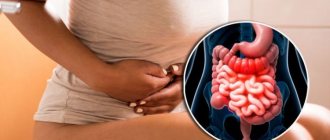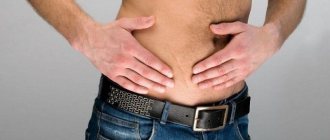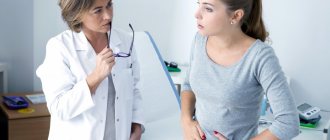If a person says: “I have abdominal pain,” then it is important to understand: behind abdominal pain there may be problems with any organs of the abdominal cavity, retroperitoneal space, or small pelvis.
If a person says: “I have abdominal pain,” then it is important to understand: behind abdominal pain there may be problems with any organs of the abdominal cavity, retroperitoneal space, or small pelvis. The intestines (ileum, jejunum, colon, sigmoid, colon, transverse colon), appendix, stomach, liver, duodenum, spleen, ureters, kidneys, mesenteric (mesenteric) vessels of the intestine can cause painful sensations in the abdomen. Therefore, pathologies can be gastroenterological, surgical, gynecological, or urological in nature.
Types of pain
Abdominal pain can be very different:
- Acute and chronic . Acute pain occurs suddenly, chronic pain develops gradually, its intensity increases step by step - sometimes over several weeks. In this case, a special type is formed by chronically recurrent abdominal pain. They can suddenly make themselves felt, and then also suddenly pass and resume after a certain period of time.
- Tonic and clonic . With tonic pain, the muscles are very tense, compacted areas appear on the abdomen, and uncontrolled muscle contraction is observed. Tonic pain is accompanied by fairly rhythmic spastic spasms.
- Burning (cutting) and aching – reminiscent of hunger.
The localization of pain can be the abdominal cavity, hypochondrium, areas above or below them.
The nature of pain in the lower abdomen in women
When visiting a doctor, it is important to provide comprehensive information about your health condition. You need to pay attention to the circumstances under which you experienced discomfort, as well as the nature of the manifestations. So, for example, you may experience:
- acute pain in the lower abdomen in women. Sometimes it is called piercing;
- nagging discomfort;
- cutting pain;
- cramping pain. They are accompanied by spasms.
It is also important to consider when exactly you felt discomfort. According to the time of occurrence, there are:
- sharp pain in the lower abdomen in women. They appear suddenly and are characterized by high intensity;
- chronic pain. They may be felt for some time, and then subside and reappear after a certain period.
Symptoms
A person who complains of abdominal pain may have different symptoms. Most often it manifests itself in the form of spasms and colic.
- Colic is an attack of primarily stabbing (hence the name) pain. In case of colitis, a person has colitis in both sides, in case of appendicitis or inflammation of the ovaries - in the lower abdomen, in case of poisoning, the localization of colic can be in different parts of the abdomen and most often an additional symptom appears (vomiting, diarrhea).
- Spasms are pain that is accompanied by involuntary muscle contraction. At the same time, the skin turns pale. The pain may cause the person to lose consciousness. If the spasms are due to inflammatory diseases of the intestines or stomach, they are accompanied by fever. Gynecological problems are indicated by spasms accompanied by bleeding.
- Anginal pain is an unpleasant sensation with a strong burning sensation.
- Sharp pain in the area above the navel is a common occurrence with appendicitis.
- A feeling of “fullness” in the lower back may indicate problems with the colon
- Cyclic pain (either intensifies or subsides) is a characteristic symptom of diseases of the bladder and intestines.
- Pain accompanied by severe gas formation indicates improper functioning of the colon.
- Painful sensations accompanied by itching of the anus are symptoms of damage to the rectum.
- Unpleasant sensations in the abdomen , intensifying at rest and disappearing with movement, are the result of problems with blood circulation.
Pelvic organ prolapse
With age or during pregnancy and childbirth, the pelvic floor muscles may weaken, causing the uterus, vagina and bladder to move downwards. This is not a dangerous condition, but it leads to a feeling of discomfort and makes sexual intercourse painful. Special Kegel exercises help strengthen the pelvic floor muscles.
Varicose veins of the pelvic veins
Varicose veins can occur not only on the legs. Dilatation of the pelvic veins leads to pain, which intensifies when the woman sits or stands. When lying down, symptoms decrease or disappear. Varicose veins of the pelvic veins are treated surgically.
Causes
What are the causes of abdominal pain, dysfunction of the abdominal organs and retroperitoneal space?
The cause of colic can be appendicitis, inflammation of the ovaries (in these cases, colic in the lower abdomen), poisoning, or colitis. With colitis, a person has colitis in both sides. If the colic is cramping and is localized both in the abdomen and in the lower back, the pain is more intense, the cause is most often urolithiasis, kidney injuries or pyelonephritis. Colic in the navel area may be a response to irritants of the sensitive mesenteric plexus of the intestine.
Among the common causes of paroxysmal spasms are intestinal obstruction and gastroduodenitis. And uterine endometriosis is most often behind spasms during urination in women.
If abdominal pain is accompanied by increased gas formation and a frequent urge to defecate, then the cause will most often be associated with diseases of the colon.
If you have abdominal pain - anginal, and the patient is bothered by an expressive burning sensation - the cause is most often gastritis (inflammation of the stomach lining) or pancreatitis (inflammation of the pancreas). If pain and burning are accompanied by severe tension in the muscles of the abdominal wall, and a person complains of pressure in the chest, the cause may be associated with heart pathologies: in particular, such pain is typical for 60% of patients with myocardial infarction.
The cause of abdominal pain accompanied by low-grade fever (the temperature remains at 37.1–37.5 °C for a long time) is most often inflammatory bowel disease.
Which specialist should I contact?
It all depends on the reason why your stomach hurts. Initially, you should contact a therapist who works at (academician Roitberg’s clinic). He will perform a diagnosis and then refer you to the right specialist. If the diagnosis is fibroids, then you will need to consult a gynecologist (), if a person has kidney stones, then you need a nephrologist (), if you have diagnosed a duodenal or gastric ulcer, then you need the help of a gastroenterologist (). In case of ovarian torsion or appendicitis, the patient is referred to a surgeon (), and with bruises and injuries the patient will be treated by a therapist ().
To contact JSC "Medicine" (metro Mayakovskaya, metro Belorusskaya, metro Tverskaya, metro Chekhovskaya), you should dial phone numbers or drive up in person. If you have abdominal pain on the left side and want to reach a therapist, who should always begin examining the patient, dial the phone number.
Diseases
Most often, abdominal pain is caused by diseases of the intestines, stomach, pancreas, problems with the gallbladder, as well as hernias.
Intestinal diseases
- Ulcerative colitis is a diffuse inflammation. The rectal mucosa is affected. In the initial forms of ulcerative colitis, inflammation affects only the proximal part (the entrance to the intestine); in advanced forms, the problems affect the entire colon. As the disease progresses and worsens, the patient feels a sharp deterioration in health, the body begins to become intoxicated, the pulse quickens, and in most cases blood appears in the stool. If the disease is not treated, the body can poison itself, and peritonitis can develop - damage to the abdominal cavity that poses a threat to life.
- Enteritis . The small intestine becomes inflamed. At first, the disease is “masked” as a disease, and often accompanies this problem. If the disease is not treated in a timely manner, the functions of the small intestine are disrupted. Food begins to be poorly absorbed by the intestinal walls. Digestion processes are disrupted.
- Crohn's disease . One or several areas of the intestine can become inflamed. But almost always the inflammation affects the junction of the large and small intestines. One of the most unpleasant aspects is that the inflammation affects the entire thickness of the wall, and a complication of the disease is intestinal obstruction syndrome, the treatment of which requires the adoption of a set of measures related to the simulation of motility and restoration of intestinal function.
- Dysbacteriosis is a disorder of the intestinal microflora. The number of beneficial bacteria in the intestines is reduced, and pathogenic microflora develops. As a result, gas formation occurs, a person cannot digest food, and bowel movements are disrupted. Very often, the development of dysbiosis is a consequence of incorrect antibiotic therapy or a reaction to stress.
Pancreatic diseases
- Pancreatitis . The most common disease affecting the pancreas is pancreatitis. When the pancreas is inflamed, a person feels severe discomfort in the upper abdomen, and it becomes difficult for the body to digest proteins and fats. Often in everyday life they say in this case: “There are not enough enzymes.” And this really reflects the real picture. In the affected pancreas, the production of lipase, chymotrypsin, and trypsin is significantly reduced.
- Cystic fibrosis is a disease that disrupts the functioning of the pancreas and respiratory system. It is a non-inflammatory pathology. The reason is hereditary factors. A complication of the disease may be the formation of a duodenal ulcer.
Stomach diseases
Some of the most common diseases that affect people of all ages are accompanied by abdominal pain - these are pathologies of the stomach, especially its mucous membrane. The leaders are gastritis, ulcers, gastroesophageal reflux disease.
- Gastritis . It is an inflammation of the gastric mucosa. The entire stomach or certain parts of it can become inflamed. With gastritis, pain with burning and spasms predominate. The patient is concerned about discomfort after eating, a feeling of a full stomach or, on the contrary, “sucking” and a constant feeling of hunger. Accompanying the disease in the acute stage are vomiting and nausea.
- Stomach ulcer . Pain occurs against the background of characteristic ulcerative damage to the gastric mucosa. Dyspeptic symptoms are pronounced: heaviness in the stomach, a feeling of oversaturation of the stomach, pain in the epigastric region.
- Gastroesophageal reflux disease (popularly known as “reflux”). The disease is associated with a weakening of the valve between the stomach and esophagus. The result of this weakening is pain, accompanied by heartburn. Very often, gastroesophageal reflux disease appears in patients who have already experienced gastritis or a stomach ulcer.
Pathologies of the reproductive system
There are many causes of pain associated with gynecological problems. Among the most common:
- Endometritis. It is characterized by inflammation of the endometrium, which can occur acutely or chronically. Often accompanied by menstrual irregularities, spotting, uterine bleeding, and nagging pain.
- Adnexitis. Inflammation of the uterine appendages is one of the most common diseases in gynecological practice. In addition to painful sensations (can be in one side or spread to the entire lower abdomen), patients are faced with signs of intoxication and fever. The disease is caused by bacteria, viruses or fungi.
- Endometriosis. In this disease, the cells of the uterus grow and end up outside the uterus. Accompanied by pain during urination, defecation, sexual intercourse and simply with sudden movements, heavy bleeding during menstruation. Regardless of the cycle, brownish discharge is observed.
- Uterine fibroids, which are usually characterized by dull pain in the pelvic area. Cysts and other benign, as well as malignant formations can cause discomfort of varying intensity and spasms.
- Spikes. They may be the result of inflammation in the genital organs, varicose veins and other diseases. Complications during pregnancy. This may include spontaneous abortion, placental abruption and other pathologies. In such cases, the pain is sudden and sharp, accompanied by bleeding from the genitals.
Separately, it is worth focusing on sexually transmitted infections - mycoplasmosis, gonorrhea, chlamydia, trichomoniasis and other diseases. They affect the reproductive organs, causing pain, profuse vaginal discharge of a pathogenic nature, burning, itching and are fraught with complications if left untreated.
Hernias
Often abdominal pain is caused by peritoneal hernias. They can be umbilical, inguinal, diaphragmatic. Umbilical hernias are more often formed during pregnancy or in the postpartum period, inguinal hernias - with excessive stress, diaphragmatic hernias - defects of the abdominal wall that form as a reaction to improper bowel function, an incorrectly selected corset, or heavy lifting. The insidiousness of diaphragmatic hernias is that at the initial stage of the disease, a person believes that he has typical gastritis - with heartburn and belching, but traditional therapy does not provide treatment, and ultrasound shows that the cause is not inflammation of the stomach, but precisely the presence of a hernia. In toga, to combat pathology, it is not necessary to relieve inflammation or eliminate spasms, but to undergo surgical treatment, which is aimed at strengthening the abdominal wall.
Diseases of the gallbladder and bile ducts
A special group consists of diseases associated with the gallbladder and bile duct.
- Cholangitis . Inflammation of the bile ducts. The pain is unbearable. Mainly on the right side. It is complicated by the fact that it requires not only quick relief from the attack of pain itself, but also normalization of blood pressure.
- Cholecystitis . Acute pain due to eating fatty foods. Often the pain itself is followed by vomiting mixed with bile. Flatulence (gas formation) and vomiting may occur.
- Gallstone disease is the formation of hard structures – stones – in the bile. Pain in the disease is paroxysmal. Especially if the stones move through the gallbladder and ducts.
Ovarian cyst
The ovaries contain follicles - sacs in which eggs mature. A mature follicle ruptures during ovulation and releases an egg. If this does not happen, it turns into a cyst. Such ovarian cysts are usually harmless and can go away on their own, but they can cause pain and an enlarged abdomen. When the cyst is torsioned, a threatening condition occurs - severe acute pain should force you to immediately consult a doctor. Ovarian cysts are detected during a gynecological examination and ultrasound.
Contraindications
An incorrect diagnosis can lead to the fact that treatment will not only be useless, but will provoke serious complications. After all, many medications and physiotherapeutic techniques that are effective for some diseases accompanied by abdominal pain are strict contraindications for other diseases with similar symptoms.
For example, if a number of medications prescribed for pancreatitis are given to patients with hepatic colic, the reaction may be unpredictable. And treating a number of stomach diseases with antibiotics can cause serious dysbiosis.
And absolute contraindications for pain in the abdomen or stomach are self-medication - especially independent decision-making to take a painkiller or antispasmodic. If, for example, such drugs are used by a person whose appendix is inflamed, relief will follow for a while. But this will not be help, but false help to yourself. There are often cases when patients who did not get to the surgeon in a timely manner to remove appendicitis began to experience necrosis of the tissues of neighboring organs.
Under no circumstances should you resort to even seemingly “harmless” means to combat high acidity without making a diagnosis. What seems to be simply a release of excess hydrochloric acid and inflammation of the stomach may turn out to be a symptom of a completely different disease, such as a heart attack.
Also, for abdominal pain with an unclear diagnosis, you should not apply a heating pad with hot water. In a number of pathologies, heat only accelerates the inflammatory process and activates bleeding.
Conservative treatment of pathologies that cause pain in the lower abdomen in women
The doctor chooses the treatment tactics after an examination. The medications will be prescribed to you after the clinical picture has been clarified. At the same time, it is important to adhere to the specialist’s recommendations regarding the daily routine, nutrition, and water regime. Afterwards you may be recommended to take the following medications:
- antibiotics. Required for infections. The doctor selects a group of drugs based on their underlying cause;
- hormones. Used to correct fibroids, endometriosis, severe dysmenorrhea and other pathologies. Combined oral contraceptives are often prescribed. They are selected individually for each patient;
- painkillers. Analgesics and antispasmodics can be taken for inflammation, as well as dysmenorrhea.
Surveys
An effective examination of a patient who is bothered by abdominal pain consists of an interview, palpation of the abdomen, and laboratory and functional diagnostics.
For a doctor to make a diagnosis, the smallest details are important. For example, even a basic assessment of stool can clarify a lot in the case of abdominal pain.
- Hard lumps (“sheep” feces) are a frequent companion to colitis, elongation of the sigmoid colon, and gastric ulcers.
- Watery stools often accompany poisoning and infectious diseases.
- With a parasitic disease (presence of worms in the intestines), dysbacteriosis, stool particles are usually very loose.
Also, to select a tool and diagnostic technology, an oral interview with the patient is important. The doctor asks the patient how long the pain lasts, whether there are attacks, what exactly causes the pain - physical movements, going to the toilet, eating, taking a certain position.
Diagnostics
The following types of research are especially valuable for identifying the cause of the disease and finding treatment methods for pathologies of the abdominal cavity:
- Ultrasound of the abdominal cavity. One of the most prompt measures in diagnosing diseases of the abdominal and pelvic organs and identifying the cause of abdominal pain is ultrasound diagnostics. Using ultrasound, you can identify pathologies of the liver, gall bladder, spleen, kidneys, uterus, and ovaries. Many people wonder whether the stomach and intestines are visible on an ultrasound. The stomach cannot be examined using ultrasound; the intestines cannot be examined partially. If the equipment has good resolution, for example, volumetric formations in this area are visible.
- FGDS (gastroscopy, probing, intestinal swallowing) is a diagnostic method that can be used to obtain an objective picture of the condition of the stomach, duodenum, and esophagus. If necessary, you can immediately conduct a rapid test for Helicobacter pylori (the cause of the development of ulcers), do cytology and biopsy to exclude the oncological nature of the disease, and determine “acidity”.
- X-ray. An old, but still practiced method of diagnosis. It can be used as an emergency measure to examine the stomach if for some reason an FGDS cannot be done. In addition, x-rays are informative in identifying diseases accompanied by symptoms of intestinal obstruction. Depending on the nature of the patient’s pain and complaints, traditional X-rays or contrast-enhanced X-rays (irrigoscopy) may be used.
- MRI is a progressive diagnostic method for abdominal injuries, liver enlargement, and an uninformative picture of the abdominal cavity on ultrasound (for example, due to severe flatulence).
- Colonoscopy. One of the most accurate methods for examining the intestines. This is done using a fiber colonoscope. Using the device, you can examine everything - even the most complex areas, including the inner surface of the colon.
- Cholescintigraphy . Isotopic study. It is carried out using a radiopharmacological drug. Informative for problems with the gallbladder and bile ducts.
- Blood, urine and canal analysis . In the blood test, special emphasis is placed on ESR (inflammation can be determined by the erythrocyte sedimentation rate), biochemical indicators, and in many types of examinations for abdominal pain, stool is examined for occult blood.
Myofascial pain syndrome (MPS)
Quite often, the source of pelvic pain is the muscles and ligaments. This condition is called myofascial pain syndrome and has the following causes:
- muscle and ligament sprains;
- bruises;
- frequent minor muscle injuries, for example, during heavy physical work or sports;
- overstrain of the pelvic muscles, when you have to maintain an uncomfortable position for a long time;
- Sometimes the cause is hypothermia and frequent stress.
There can be many causes of pelvic pain. Sometimes it is difficult for a doctor to determine the cause of this condition without additional examinations. If you are worried about pelvic pain, make an appointment with a gynecologist at ProfMedLab, our phone number: +7 (495) 120-08-07.
Need more interesting articles:
13 reasons to get tested for hormones 02/08/2017
Working night shifts increases the risk of developing breast cancer 07/08/2019
Why is it good to cry? 05/19/2017
What to do?
So, the main thing for abdominal pain is not to self-medicate, and not to delay visiting a doctor and getting a diagnosis.
At the same time, in some cases, it is important not just to make an appointment at the clinic, but to immediately call an ambulance. In what cases is an ambulance required?
- Abdominal pain is very intense.
- Cold sweat appears.
- Severe vomiting of blood begins.
If the pain is not acute, there is no blood in the vomit, the temperature differs from that of a healthy person, but there is no fever, consultation with a therapist, gastroenterologist and diagnosis are recommended.
Timely diagnosis is a guarantee that the most gentle methods will be used to combat the disease. Even if we are talking about surgery.
- Laparoscopy is used to remove gallstones and appendicitis (if the situation is not advanced).
- Laparoscopic funduplication is used to treat gastroesophageal reflux disease.
- To effectively solve problems with hernias and strengthen the abdominal wall, surgical hernioplasty is used.
If there are no indications for surgical treatment, the therapeutic effect for many diseases of the intestines and stomach is provided by an integrated approach, which is based on diet therapy, physiotherapy and drug therapy - antibiotics, antiparasitic drugs, corticosteroids, prokinetics to improve intestinal motility.
Surgical treatment of diseases that cause pain in the lower abdomen in women
Some conditions accompanied by this symptom require surgical treatment. Some of them are urgent, including ectopic pregnancy. In this case, removal of the fallopian tube or tubotomy is performed - an intervention that helps preserve reproductive health.
You can also undergo an oophorectomy, wedge resection of the ovary, or adnexectomy if indicated. Hernias and appendicitis also require surgical treatment.
Conclusion
Pain in the lower abdomen in women significantly reduces the quality of life. Don't try to endure the discomfort. Acute conditions can become chronic, which often leads to complications. Acute intense pain is a signal to immediately seek medical help. It may be a sign of a life-threatening condition.
Where to go?
The doctors of the 5th Clinical Hospital have extensive experience in performing laparoscopic operations and hernioplasty in Minsk.
In addition to accepting patients who are citizens of Belarus, the 5th City Hospital of Minsk also accepts foreign citizens (on a paid basis). Each of them can undergo comprehensive diagnostics and treatment at the surgical and therapeutic departments.
The hospital has its own clinical diagnostic laboratory, X-ray department, X-ray CT and MRI rooms. The physiotherapy department has all the conditions for conducting rehabilitation programs.
Prevention
Doctors at the 5th Hospital will not only select the optimal diagnostic and treatment option for each patient, but will also advise on how to prevent relapses.
Diet occupies a special place among measures to prevent intestinal and stomach diseases. It is important to learn to maintain balance in nutrition. You should not overeat; you should chew food carefully and slowly. Water and willow tea https://teahelp.ru/tea/herbal-tea/ivan-chaj/ should be consumed in sufficient quantities; coffee is not recommended in this case. At the same time, when choosing a diet, experienced doctors take into account all factors:
- functional state of the intestines, liver, pancreas
- secretory function of the stomach,
- intestinal motility,
- the presence of other concomitant diseases.
In addition to your diet, it is important to reconsider how you store and process food. Do not leave food open in the sun. Avoid damp food storage areas. Otherwise, they may begin to mold and rot. Avoid contact between raw foods and cooked foods.
Exercise therapy is also of great importance in the complex of preventive measures. Instructors-methodologists select their own loads and exercises for each patient.







